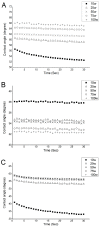Retention of Antibacterial Activity in Geranium Plasma Polymer Thin Films
- PMID: 28902134
- PMCID: PMC5618381
- DOI: 10.3390/nano7090270
Retention of Antibacterial Activity in Geranium Plasma Polymer Thin Films
Abstract
Bacterial colonisation of biomedical devices demands novel antibacterial coatings. Plasma-enabled treatment is an established technique for selective modification of physicochemical characteristics of the surface and deposition of polymer thin films. We investigated the retention of inherent antibacterial activity in geranium based plasma polymer thin films. Attachment and biofilm formation by Staphylococcus aureus, Pseudomonas aeruginosa, and Escherichia coli was significantly reduced on the surfaces of samples fabricated at 10 W radio frequency (RF) power, compared to that of control or films fabricated at higher input power. This was attributed to lower contact angle and retention of original chemical functionality in the polymer films fabricated under low input power conditions. The topography of all surfaces was uniform and smooth, with surface roughness of 0.18 and 0.69 nm for films fabricated at 10 W and 100 W, respectively. Hardness and elastic modules of films increased with input power. Independent of input power, films were optically transparent within the visible wavelength range, with the main absorption at ~290 nm and optical band gap of ~3.6 eV. These results suggest that geranium extract-derived polymers may potentially be used as antibacterial coatings for contact lenses.
Keywords: antibacterial coatings; essential oils; geranium oil-derived polymer; plasma polymerisation.
Conflict of interest statement
The authors declare no conflict of interest.
Figures








Similar articles
-
Eco-friendly nanocomposites derived from geranium oil and zinc oxide in one step approach.Sci Rep. 2019 Apr 12;9(1):5973. doi: 10.1038/s41598-019-42211-z. Sci Rep. 2019. PMID: 30979934 Free PMC article.
-
Investigation of Antibacterial 1,8-Cineole-Derived Thin Films Formed via Plasma-Enhanced Chemical Vapor Deposition.ACS Appl Mater Interfaces. 2017 Oct 25;9(42):36548-36560. doi: 10.1021/acsami.7b09067. Epub 2017 Oct 16. ACS Appl Mater Interfaces. 2017. PMID: 28984443
-
Electrically Insulating Plasma Polymer/ZnO Composite Films.Materials (Basel). 2019 Sep 23;12(19):3099. doi: 10.3390/ma12193099. Materials (Basel). 2019. PMID: 31547551 Free PMC article.
-
Polymer Thin Films and Surface Modification by Chemical Vapor Deposition: Recent Progress.Annu Rev Chem Biomol Eng. 2016 Jun 7;7:373-93. doi: 10.1146/annurev-chembioeng-080615-033524. Annu Rev Chem Biomol Eng. 2016. PMID: 27276550 Review.
-
Advances in Antibacterial Polymer Coatings Synthesized via Chemical Vapor Deposition.Chem Bio Eng. 2024 Jun 14;1(6):516-534. doi: 10.1021/cbe.4c00043. eCollection 2024 Jul 25. Chem Bio Eng. 2024. PMID: 39974606 Free PMC article. Review.
Cited by
-
The Influence of Physical Fields (Magnetic and Electric) and LASER Exposure on the Composition and Bioactivity of Cinnamon Bark, Patchouli, and Geranium Essential Oils.Plants (Basel). 2024 Jul 21;13(14):1992. doi: 10.3390/plants13141992. Plants (Basel). 2024. PMID: 39065519 Free PMC article.
-
Plasma and Polymers: Recent Progress and Trends.Molecules. 2021 Jul 5;26(13):4091. doi: 10.3390/molecules26134091. Molecules. 2021. PMID: 34279431 Free PMC article. Review.
-
Anti-arthritic effects of geranium essential oil loaded chitosan nanoparticles in Freund's complete adjuvant induced arthritic rats through down-regulation of inflammatory cytokines.Inflammopharmacology. 2023 Aug;31(4):1893-1912. doi: 10.1007/s10787-023-01233-w. Epub 2023 May 25. Inflammopharmacology. 2023. PMID: 37231284
-
Atmospheric Pressure Plasma Polymerisation of D-Limonene and Its Antimicrobial Activity.Polymers (Basel). 2023 Jan 6;15(2):307. doi: 10.3390/polym15020307. Polymers (Basel). 2023. PMID: 36679188 Free PMC article.
-
Eco-friendly nanocomposites derived from geranium oil and zinc oxide in one step approach.Sci Rep. 2019 Apr 12;9(1):5973. doi: 10.1038/s41598-019-42211-z. Sci Rep. 2019. PMID: 30979934 Free PMC article.
References
-
- Knetsch M.L.W., Koole L.H. New strategies in the development of antimicrobial coatings: The example of increasing usage of silver and silver nanoparticles. Polymers. 2011;3:340–366. doi: 10.3390/polym3010340. - DOI
-
- Lichter J.A., Van Vliet K.J., Rubner M.F. Design of antibacterial surfaces and interfaces: Polyelectrolyte multilayers as a multifunctional platform. Macromolecules. 2009;42:8573–8586. doi: 10.1021/ma901356s. - DOI
-
- Edmiston C.E., Jr., McBain A.J., Roberts C., Leaper D. Biofilm-Based Healthcare-Associated Infections. 1st ed. Springer International Publishing; Cham, Switzerland: 2015. Clinical and microbiological aspects of biofilm-associated surgical site infections; pp. 47–67. - PubMed
LinkOut - more resources
Full Text Sources
Other Literature Sources
Molecular Biology Databases
Miscellaneous

